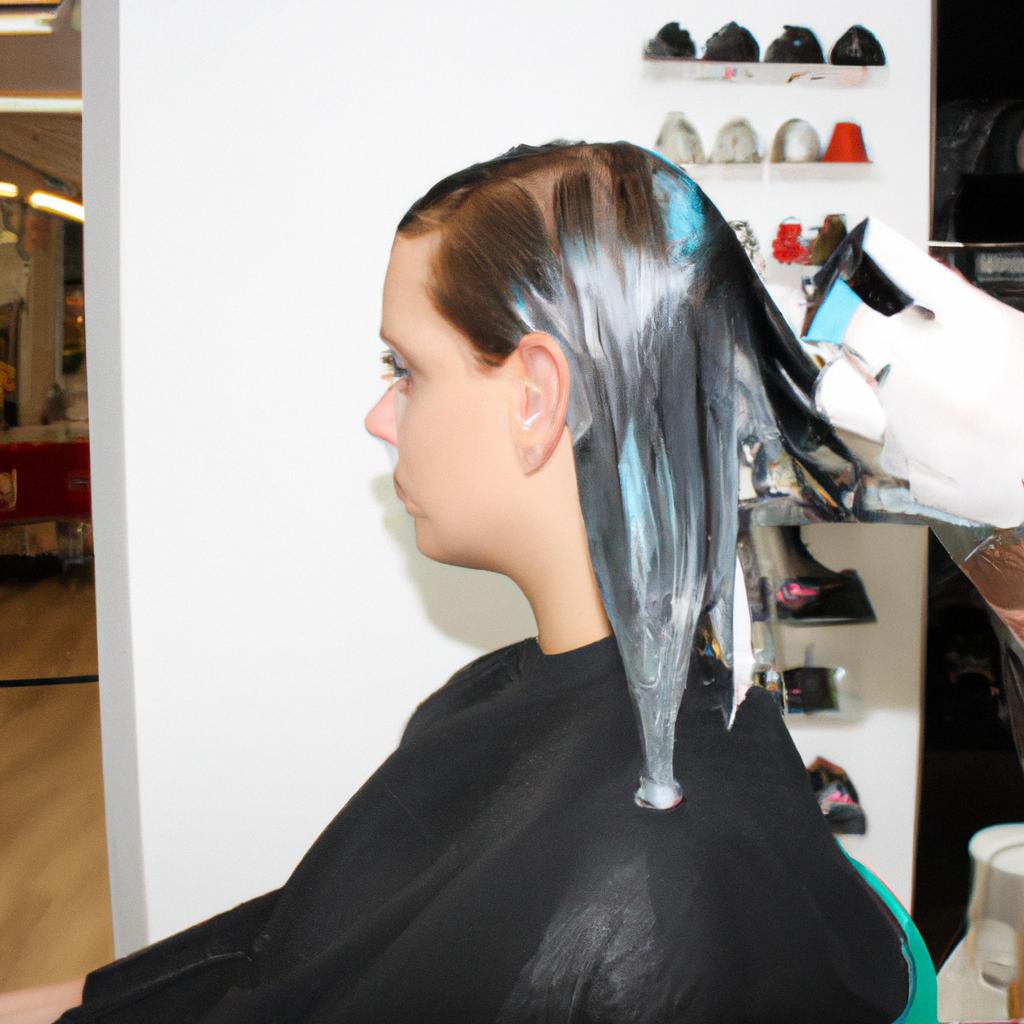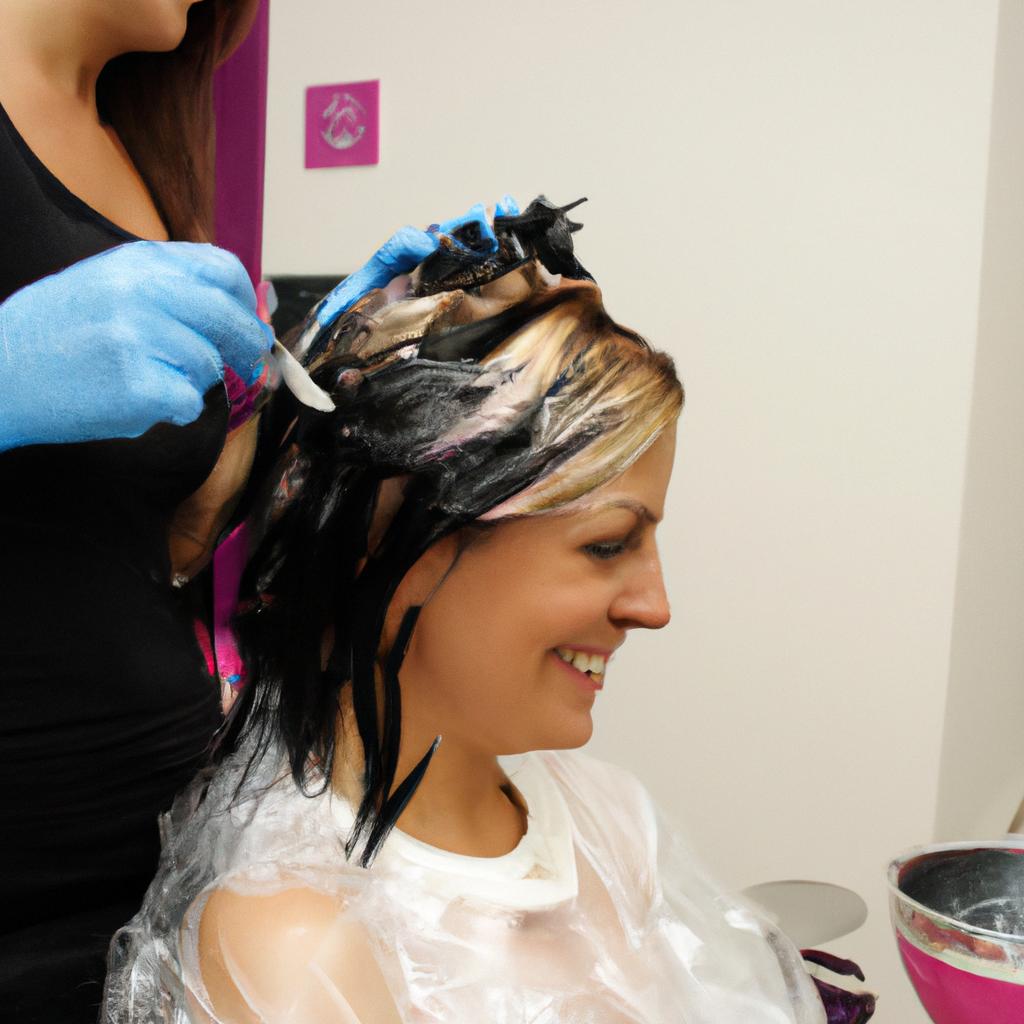Ombré is a popular coloring technique in hairdressing salons that creates a gradient effect, with the color transitioning from dark to light. This technique has gained significant popularity among clients seeking a subtle and natural-looking change in their hair color. For instance, imagine a client named Sarah who wants to add dimension to her straight brown hair without making it look too dramatic or artificial. The ombré technique would be an ideal choice for Sarah as it allows for a seamless blend of colors, giving her hair a soft and sun-kissed appearance.
Mastering the ombré coloring techniques requires skill and expertise on the part of hairdressers. This article aims to delve into the various aspects involved in achieving flawless ombré results, including color selection, product application, blending techniques, and maintenance tips. By understanding these key elements, both novice and experienced hairstylists can enhance their proficiency in providing clients with stunning ombré transformations that suit their individual preferences and complement their natural features. Furthermore, this article will also explore how different factors such as hair type, length, texture, and skin tone influence the outcome of an ombré treatment to ensure optimal results are achieved every time.
Understanding Ombr Hair
Understanding Ombré Hair
Ombré hair has become a popular trend in the world of hairdressing, with its distinctive gradual color transition from dark to light. To comprehend ombré hair fully, it is essential to understand its characteristics and techniques. This section will explore the concept of ombré hair, including its definition, application methods, and effects on different hair types.
To illustrate the versatility of ombré hair, let’s consider an example. Imagine a client with long brunette locks wanting to add dimension and depth to her hairstyle without completely altering her natural color. By incorporating subtle caramel highlights towards the ends of her tresses, the stylist creates an alluring ombré effect that enhances the overall appearance while maintaining a seamless blend between colors.
When discussing ombré hair, several key aspects should be considered:
- Gradual Color Transition: The defining feature of ombré hair is the smooth transition from darker roots to lighter ends. This technique can range from subtle shifts in shades for a more natural look or bold contrasts for a dramatic effect.
- Customization: One significant advantage of ombré coloring is its adaptability to various individuals’ preferences and facial features. With skillful application techniques tailored to each client’s unique needs, stylists can create personalized looks that flatter specific skin tones and face shapes.
- Maintenance: Achieving stunning results with ombré requires careful consideration of maintenance routines. Since this style involves different color levels throughout the hair length, regular touch-ups may be necessary to maintain balance and vibrancy.
- Versatility across Hair Types: Ombré is not limited by hair type or texture; it can be applied to straight, wavy, or curly locks alike. Regardless of individual traits, proper consultation with clients ensures understanding their desired outcomes before commencing any coloring procedures.
By exploring these fundamental elements of ombré hair – including its smooth color transitions, customization options, maintenance considerations, and versatility across hair types – stylists can master the art of this popular coloring technique. In the subsequent section, we will delve into the crucial factors to consider when choosing the right hair color to complement an individual’s features and preferences.
Choosing the Right Hair Color
As we delve deeper into the world of ombré hair, it is important to explore the different techniques that can be used to achieve this trendy look. One popular method involves creating a seamless blend from dark roots to lighter ends, while another approach focuses on incorporating vibrant colors for a bolder effect. To better understand these coloring techniques, let’s consider a hypothetical example.
Imagine a client named Sarah who wants to transform her brunette locks into a stunning ombré style. She desires a natural gradient effect with warm caramel tones transitioning into soft honey blonde at the ends. In order to achieve this desired result, there are several key factors and considerations that need to be taken into account:
-
Color Selection: Choosing the right shades is crucial when creating an ombré look. It is essential to select hues that complement the client’s skin tone and eye color, ensuring a harmonious overall appearance.
-
Bleaching Process: Depending on the starting hair color, lightening may be required in order to create the gradual fade from dark roots to lighter ends. This process should be approached with caution, as over-bleaching can cause damage and breakage.
-
Transition Zone: The transition zone plays a vital role in achieving a flawless ombré effect. Careful blending between the darker root color and the lighter mid-lengths creates a smooth gradient without any harsh lines or demarcations.
-
Maintenance and Aftercare: Once Sarah has achieved her dream ombré hair, proper maintenance and aftercare become imperative for long-lasting results. Regular touch-ups may be needed as new growth occurs, along with nourishing treatments to keep the hair healthy and vibrant.
- Transforming your hair through ombré coloring can boost your confidence.
- Embrace change by experimenting with different shades and gradients.
- Stand out from the crowd with a unique and personalized ombré style.
- Discover the beauty of self-expression through innovative hair techniques.
Additionally, we can evoke an emotional response by presenting a table showcasing various shades and their corresponding color families:
| Color Shade | Color Family 1 | Color Family 2 | Color Family 3 |
|---|---|---|---|
| Caramel | Warm | Neutral | Golden |
| Honey Blonde | Cool | Ash | Pearl |
| Chocolate | Rich | Mahogany | Mocha |
| Platinum | Ice | Silver | Violet |
In conclusion, understanding the different coloring techniques involved in achieving an ombré look is essential for hairdressers. By carefully selecting colors, executing precise bleaching processes, blending transition zones seamlessly, and providing proper maintenance advice to clients like Sarah, hairstylists can master this popular trend. In our next section on “Preparation for Ombr Coloring,” we will explore the necessary steps before embarking on the actual coloring process.
Preparation for Ombr Coloring
Section H2: Preparation for Ombr Coloring
Before diving into the process of ombré coloring, it is essential to properly prepare both the hair and the client. A successful ombré technique requires careful consideration of various factors, such as hair condition, desired outcome, and client preferences. By following a systematic approach to preparation, hairdressers can ensure optimal results and client satisfaction.
Example:
Consider a hypothetical scenario where a client with naturally dark brown hair desires a subtle transition to caramel tones towards the ends. To achieve this look successfully, proper preparation becomes crucial. Neglecting any step in the process may lead to undesired outcomes or damage to the hair.
Key Steps in Preparing for Ombré Coloring:
-
Consultation and Analysis:
- Conduct an initial consultation with the client to understand their expectations.
- Analyze various factors like skin tone, eye color, and lifestyle before suggesting suitable shades for the ombré effect.
- Discuss potential maintenance requirements and any limitations based on current hair conditions.
-
Hair Assessment and Treatment:
- Evaluate the overall health of the client’s hair by examining its texture, porosity, and existing color treatments.
- Perform necessary treatments like deep conditioning or protein treatments to improve hair strength and integrity.
- Address any concerns related to split ends or other damages before proceeding with coloring.
-
Sectioning Technique:
- Use appropriate sectioning techniques based on the desired placement of colors and effects.
- Divide the hair into sections that will allow for smooth blending between different shades during application.
-
Protecting Surroundings:
Points Cover clothing with cape Apply protective cream/vaseline along the forehead and ears Place towels underneath client’s neck Use gloves throughout entire process
By thoroughly preparing for the ombré coloring technique, hairdressers can ensure a seamless and satisfying experience for both themselves and their clients. Adequate consultation, hair assessment, sectioning techniques, and protective measures are vital steps that contribute to achieving desired results while maintaining the integrity of the hair. With this groundwork laid out, we can now move on to exploring the application process involved in creating stunning ombré hairstyles.
With preparations complete, it is time to delve into the exciting world of applying the ombré technique.
Applying the Ombr Technique
Having thoroughly prepared for the ombré coloring process, it is now time to delve into the intricate art of applying this technique. With a solid foundation in place, hairdressers can confidently proceed with creating stunning and seamless gradients that will leave their clients feeling elated.
Applying the Ombré Technique:
To demonstrate the effectiveness of the ombré technique, let us consider a hypothetical case study involving Sarah, a young woman who desires a subtle yet noticeable change in her hair color. Sarah’s natural dark brown locks are complemented by caramel highlights which she wishes to seamlessly transition into lighter shades towards the ends. This transformation will add depth and dimension to her hairstyle while maintaining an overall harmonious look.
In order to achieve optimal results during an ombré coloring session, there are several key considerations that must be borne in mind:
- Product Selection: Choosing high-quality hair dyes that offer a range of shades suitable for achieving smooth color transitions.
- Sectioning Techniques: Employing precise division techniques to ensure even distribution of color throughout the hair.
- Application Methods: Utilizing various application methods such as balayage or foil placement to create customized effects.
- Processing Time: Monitoring processing times carefully to avoid overexposure or underdevelopment of color.
By following these guidelines and incorporating their own expertise, hairdressers can truly master the artistry behind ombré coloring. The table below illustrates some essential tips and tricks that professionals often utilize during this process:
| Tips for Mastering Ombré Coloring |
|---|
| Apply lightener more heavily on mid-lengths and ends |
| Use a gentle backcombing technique for soft blending |
| Focus on feathering out any harsh lines |
| Finish with toner or glaze for added shine |
As one delves deeper into mastering ombré coloring techniques, the focus shifts towards blending and transitioning colors seamlessly. This next aspect will be explored in detail in the subsequent section.
Understanding how to blend and transition colors effectively is crucial in achieving a flawless ombré look. By employing various methods, hairdressers can create stunning gradients that seamlessly flow from dark to light hues.
Maintenance and Aftercare for Ombr Hair
Blending and Transitioning Colors are essential techniques in achieving a seamless ombré effect. By skillfully merging different shades, hairdressers can create stunning color transitions that enhance the overall look of the hairstyle. Let’s explore some key aspects of this technique.
One example of blending and transitioning colors is the case study of Emily, who had naturally dark brown hair but desired to incorporate lighter tones into her locks for a more vibrant appearance. To achieve this, her hairstylist started by applying a medium brown shade at the roots and gradually lightened it towards the ends using a balayage technique. This gradual transition created a beautiful blend between her natural hue and the lighter tones, resulting in an effortless ombré style.
To master blending and transitioning colors effectively, hairdressers should keep in mind these important considerations:
- Color Selection: Choosing complementary shades is crucial for creating harmonious blends. Experimenting with various hues within the same color family allows for subtle or bold contrasts depending on the desired outcome.
- Application Techniques: Different methods such as foiling, balayage, or hand-painting can be employed to achieve smooth color transitions. Each technique offers its own advantages depending on factors like client preferences, hair texture, and time constraints.
- Gradation Control: Skillful control over where each shade starts and ends ensures a graceful gradient effect. Careful placement of color at specific sections of the hair helps maintain balance throughout the ombré style.
- Product Knowledge: Understanding how different coloring products interact with each other and with different hair types is vital for achieving consistent results. Familiarity with product characteristics enables hairdressers to choose suitable formulas that deliver optimal outcomes.
In summary, mastering blending and transitioning colors requires expertise in selecting appropriate shades, employing varied application techniques, maintaining precise gradation control, and possessing comprehensive product knowledge. These skills allow skilled hairstylists to create personalized ombré styles tailored to their clients’ preferences and hair characteristics. By implementing these techniques effectively, hairdressers can transform ordinary hairstyles into visually stunning works of art.
Emotional Bullet Points:
- Achieving a flawless blend evokes feelings of satisfaction and confidence.
- The gradual transition between colors creates an enchanting sense of elegance.
- Personalizing ombré styles to suit individual preferences fosters self-expression.
- Mastering blending and transitioning colors provides hairstylists with a strong professional edge.
Table Example:
| Technique | Advantages | Disadvantages |
|---|---|---|
| Foiling | Precise | Time-consuming |
| Balayage | Natural look | Requires skill |
| Hand-painting | Artistic | Messy application |
By following the principles outlined above, hairstylists can successfully navigate the intricacies of blending and transitioning colors in their pursuit of mastering the art of ombré hair.




